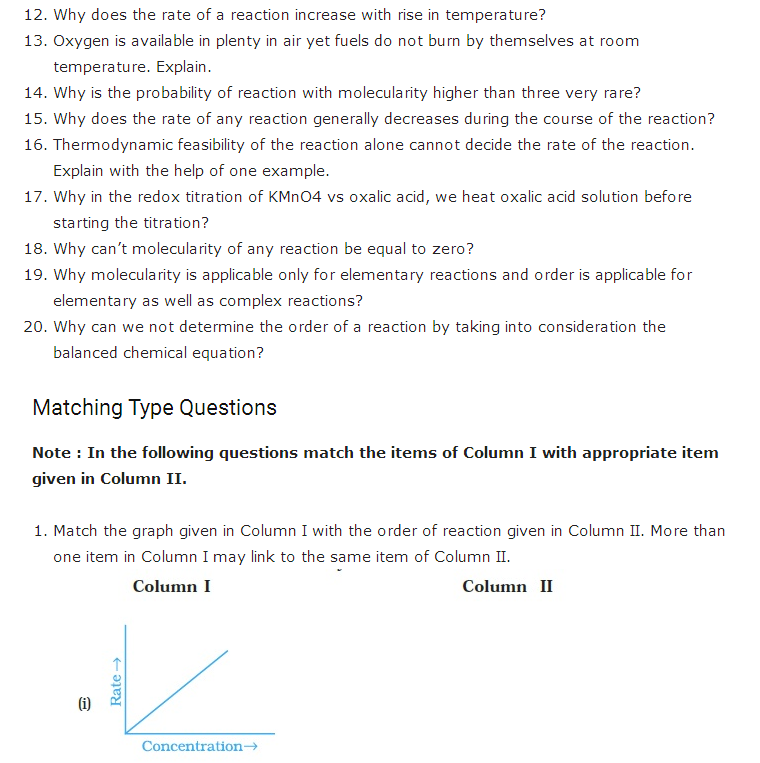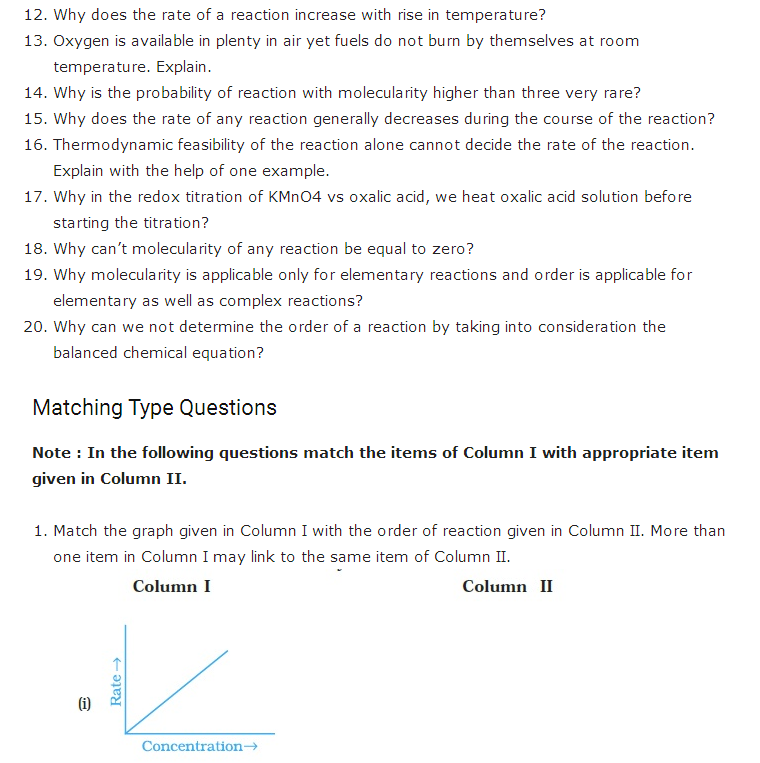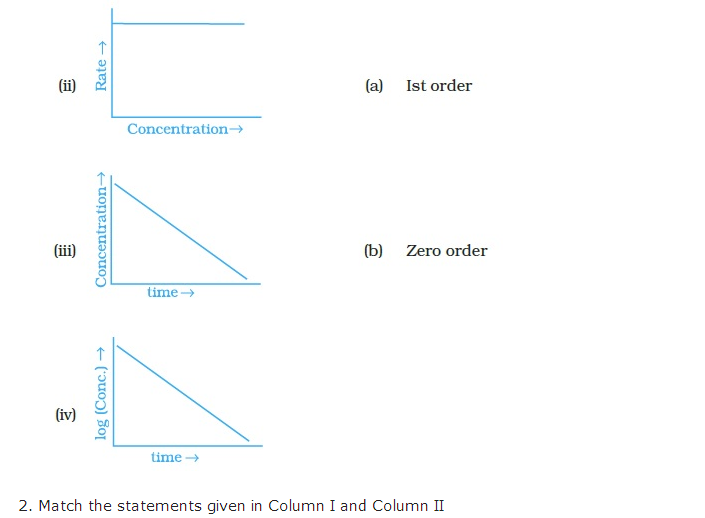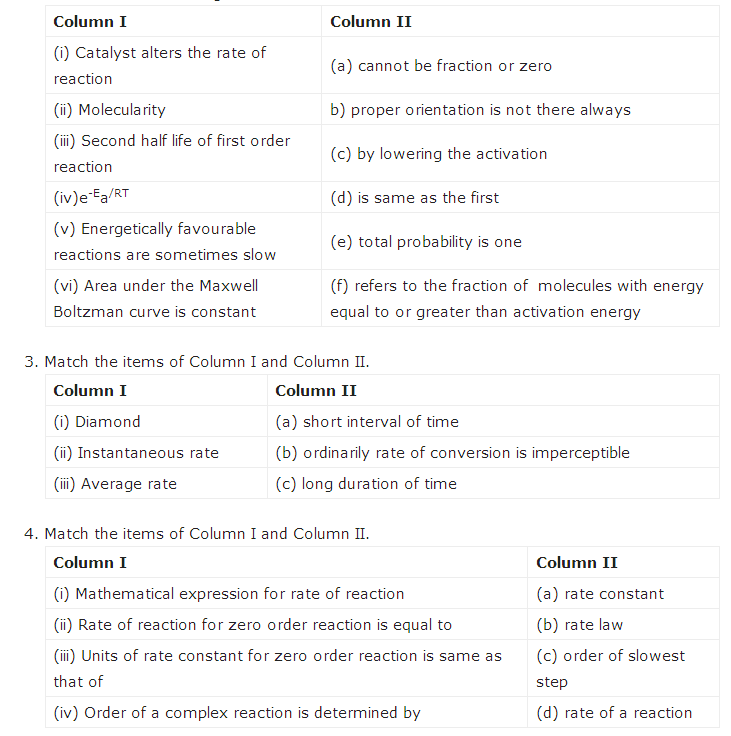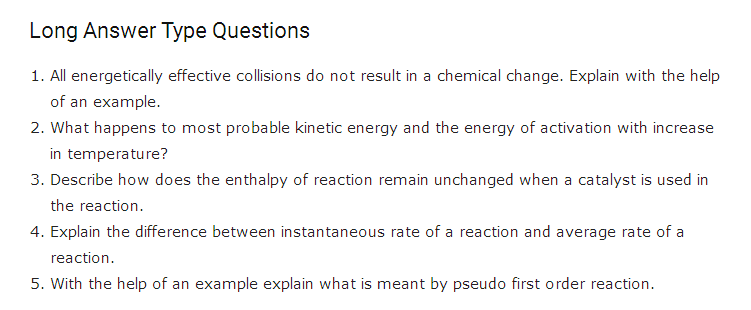Important questions of Chemical Kinetics
Question 1- A reaction is of second order with respect to a reactant. How will the rate of reaction be affected if the concentration of this reactant is (i) doubled, (ii) reduced to half?
Answer: Rate = K[A]2
(i) Rate of reaction becomes 4 times
(ii) Rate of reaction will be 1/4th
Question 2- Define:
1- Elementary step in a reaction
2- Rate of a reaction
3- Order of a reaction
4- Activation energy of a reaction
5- Rate Expression
6- Rate Constant
Answer: 1. Elementary step in a reaction: The Reactions which take place in one step. Ex: H2+I2 → 2HI
2- Rate of a reaction: The change in the concentration of any one of the reactants or products per unit time.
3- Order of a reaction: Sum of powers of molar concentrations of reacting species in the rate equation of the reaction. It can be a whole number, zero, fractional, positive or negative and is experimentally determined. It is meant for the reaction and not for its individual steps.
r = K[A]x[B]y Order = x + y
4- Activation energy of a reaction: The minimum extra amount of energy absorbed by the reactant molecules to form the activated complex.
5- Rate Expression: It expresses the rate of reaction in terms of molar concentrations of the reactants with each term raised to their power, which may or may not be same as the stoichiometric coefficient of that reactant in the balanced chemical equation.
6- Rate Constant: The rate of reaction when the molar concentration of each reactant is taken as unity.
Question 3- A reaction is of first-order in reactant A and of second order in reactant B. How is the rate of this reaction affected when (i) the concentration of B alone is increased to three times (ii) the concentrations of A as well as B are doubled?
Answer: (i) r = 9 times (ii) r = 8 times
Question 4- The thermal decomposition of HCO2H is a first order reaction with a rate constant of 2.4 × 10-3 s-1 at a certain temperature. Calculate how long will it take for three-fourths of initial quantity of HCO2 H to decompose. (log 0.25 = -0.6021)
Answer: t = 577.6 seconds
{Hint- Use formula: t = (2.303 / K) log (a / a-x)}
Question 5-(a) For a reaction A + B → P, the rate law is given by, r = k[A]1/2 [B]2.
What is the order of this reaction?
(b) A first-order reaction is found to have a rate constant k = 5.5 × 10-14 s-1. Find the half-life of the reaction.
Answer: a) 5/2
b) t1/2 = 1.26 x 10 13 s
(Hint: r = k[A]1/2 [B]2 , t1/2 = 0.693/k )
Question 6- A first order gas phase reaction : A2B2(g) → 2A(g) + 2B(g) at the temperature 400°C has the rate constant k = 2.0 × 10-4 sec-1. What percentage of A2B2 is decomposed on heating for 900 seconds? (Antilog 0.0781 = 1.197)
Answer: Percent of A2B2 decomposed = 16.45 %
Question 7-For a reaction: H2 + Cl2 → 2HCl
Rate = k
(i) Write the order and molecularity of this reaction.
(ii) Write the unit of k.
Answer: (i) This reaction is zero-order reaction and molecularity is two.
(ii) Unit of k = mol L-1 s-1
Question 8- A first-order reaction has a rate constant of 0.0051 min-1. If we begin with 0.10 M concentration of the reactant, what concentration of reactant will remain in solution after 3 hours?
Answer: [R] = 0.0399 M
(Hint- Use formula: K = (2.303/t) log ([R]0/ [R])
Question 9- For a decomposition reaction the values of rate constant k at two different temperatures are given below :
k1 = 2.15 × 10-8 L mol-1 s-1 at 650 K
k2 = 2.39 × 10-7 L mol-1 s-1 at 700 K
Calculate the value of activation energy for this reaction.
(R = 8.314 J K-1 mol-1)
Answer: Ea = 182.20 KJ
(Hint- Use formula: log k2/k1 = Ea/ 2.303R [T2-T1/ T1T2]
Question 10- Nitrogen pentoxide decomposes according to equation :
2N2O5(g) → 4 NO2(g) + O2(g).
This first-order reaction was allowed to proceed at 40°C and the data below were collected :
| N2O5 (M) | Time (min) |
| 0.400 | 0.00 |
| 0.289 | 20.0 |
| 0.209 | 40.0 |
| 0.151 | 60.0 |
| 0.109 | 80.0 |
(a) Calculate the rate constant. Include units with your answer.
(b) What will be the concentration of N2O5 after 100 minutes?
(c) Calculate the initial rate of reaction.
Answer: a) K = 0.0163 min-1
b) [A] = 0.078 M
c) R = 0.00652 M min-1
Question 11- The rate of a reaction becomes four times when the temperature changes from 293 K to 313 K. Calculate the energy of activation (Ea) of the reaction assuming that it does not change with temperature. [R = 8.314 JK-1 mol-1, log 4 = 0.6021]
Answer: Ea = 52.8 KJ mol-1
(Hint- Use formula: log k2/k1 = Ea/ 2.303R [T2-T1/ T1T2]
Question 12- For the first-order thermal decomposition reaction, the following data were obtained:
C2H5Cl(g) → C2H4(g) + HCl(g)
Time/sec Total pressure/atm
0 0.30
300 0.50
Calculate the rate constant (Given: log 2 = 0.301, log 3 = 0.4771, log 4 = 0.6021)
Answer: k = 3.66 x 10-3 s-1
{Hint- k = (2.303/t) log (Po/ 2Po-Pt)}
Question 13- If the half-life period of a first-order reaction in A is 2 minutes, how long will it take [A] to reach 25% of its initial concentration?
Answer: t75 = 4 min
{Hint: t = (2.303/k) log ([A]0/ [A] }
Question 14- Define:
1- Average rate of a reaction
2- Instantaneous rate of a reaction
3- Molecularity of a reaction
4- Pseudo first-order reaction
5- Half-life period of reaction (t1/2)
6- Specific rate of a reaction
Answer:
1- Average rate of a reaction: It depends upon the change in concentration of reactants or products and the time taken for the change to occur. R → P
Average rate = – Δ[R] / Δt or Average rate = + Δ[P] / Δt
2- Instantaneous rate of a reaction: It is the rate of change in concentration of any one of the reactant or product at a particular moment of time.
limit [- Δ[R] / Δt ] = – d[R] / dt
Δt→0
3- Molecularity of a reaction: The number of atoms, ions or molecules that must collide with one another simultaneously so as to result in a chemical reaction. Molecularity of a reaction is always a whole number.
4- Pseudo first-order reaction: The reactions which are not truly of the first order but under certain conditions become first-order reactions.
5- Half-life period of reaction (t1/2): The time taken for half of the reaction to complete.
6- Specific rate of a reaction: It is the rate of reaction when the molar concentration of each of the reactants is unity.

